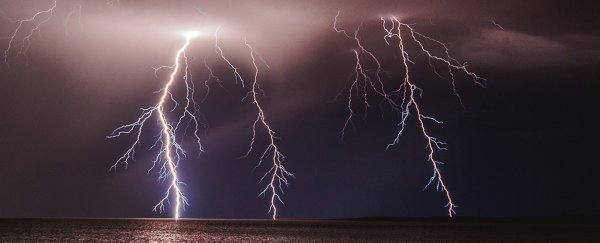Lightning is a large spark of electrical current in a planet's atmosphere.
While lightning's effects have been measured among the clouds of Venus and Jupiter, it's the bright flashes of light flickering in our own sky that we're most familiar with.
Regions close to the equator can experience as many as 150 bolts per year for every square kilometre of land, contributing to a total of more than a billion discharges annually worldwide. Around one in five of these is a ground strike.
Each current carries, on average, around 100 million volts, and is capable of stretching 300 kilometers (about 180 miles) or more.
On rare occasions bolts can reach more than twice that distance, with some 'superbolts' shining 1,000 times brighter than typical lightning strikes.
Since air acts as an insulator, resisting the flow of electricity, the push of a current can heat the surrounding atmosphere by as much as 30,000 degrees Celsius (roughly 50,000 degrees Fahrenheit) - out-sizzling the Sun's surface by tens of thousands of degrees.
The sudden rush of superheated gas expands so quickly, it creates a pressure wave we hear as thunder. The heat is also responsible for the production of a variety of atmospheric chemicals, including the ozone we rely upon for filtering out destructive ultraviolet radiation.
What causes lightning?
When tiny ice particles called graupel, or small bits of ash and rock, are violently thrown about inside thunderstorms or volcanic plumes, their charged components can separate as they rub and crash together.
Smaller particles lifted high into the atmosphere tend to lose electrons, creating a positive zone towards the tops of clouds. At the same time, larger particles fall towards the surface, bringing an excess of negative charge with them.
This difference in charge - or voltage potential - can build to extreme strengths. A single thundercloud can amass a charge of around a billion volts, though a measurement of a storm system over India in 2014 hinted at the equivalent of 1.3 billion volts.
Exactly what triggers charged regions to connect in a 'strike' still isn't well understood.
From what we can piece together, pockets of charged particles (or plasma) branch out of these charged regions into the surrounding atmosphere. Depending on whether they are negative or positive, these meandering 'leaders' will either move in distinct steps or slide smoothly through the air. Only once these paths connect can current flow between the high voltage regions.
The connection allows hundreds of quintillions of electrons through the ionised channel in milliseconds, amounting to hundreds of thousands of amps of current.
Is lightning dangerous?
Each year, an estimated 24,000 people are killed by lightning worldwide. As high as this number is, it represents just 10 percent of all injury-causing strikes.
Currents take the path of least resistance, meaning the enormous voltage could cook organs or disrupt your heart's electrical rhythm as easily as pass across your skin through more conductive materials, leaving little more than serious burns (or perhaps perforated ear drums).
With an increase in extreme weather events predicted in decades to come, these statistics are expected to rise.
What is ball lightning?
For centuries, reports of floating spheres of light the size of a grapefruit have been met with a mix of skepticism and curiosity. Common to most claims are silent, or quietly crackling blobs of glowing material floating lazily above the ground, often inside structures such as buildings or even aircraft, only to vanish in a blink.
There are many suggestions on what could be behind many of these sightings, though there still isn't a solid consensus on what 'ball lightning' is, or even if it's a single phenomenon related to lightning.
Speculations over its nature can be as mundane as a build-up of ions near insulated surfaces, such as glass window panes, or as exotic as refractive pockets of air concentrating light in strange ways.
All Explainers are determined by fact checkers to be correct and relevant at the time of publishing. Text and images may be altered, removed, or added to as an editorial decision to keep information current.
